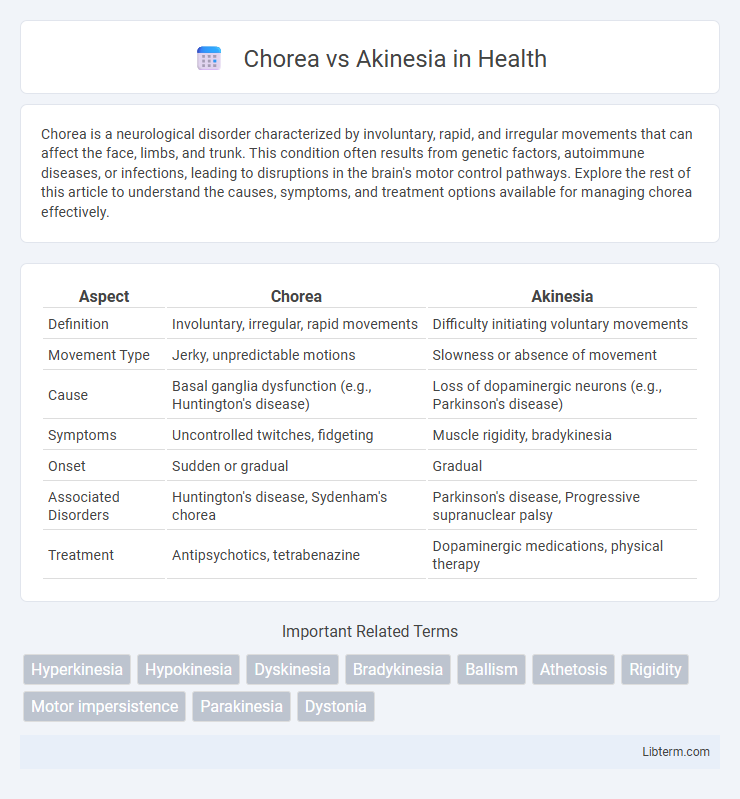Chorea is a neurological disorder characterized by involuntary, rapid, and irregular movements that can affect the face, limbs, and trunk. This condition often results from genetic factors, autoimmune diseases, or infections, leading to disruptions in the brain's motor control pathways. Explore the rest of this article to understand the causes, symptoms, and treatment options available for managing chorea effectively.
Table of Comparison
| Aspect | Chorea | Akinesia |
|---|---|---|
| Definition | Involuntary, irregular, rapid movements | Difficulty initiating voluntary movements |
| Movement Type | Jerky, unpredictable motions | Slowness or absence of movement |
| Cause | Basal ganglia dysfunction (e.g., Huntington's disease) | Loss of dopaminergic neurons (e.g., Parkinson's disease) |
| Symptoms | Uncontrolled twitches, fidgeting | Muscle rigidity, bradykinesia |
| Onset | Sudden or gradual | Gradual |
| Associated Disorders | Huntington's disease, Sydenham's chorea | Parkinson's disease, Progressive supranuclear palsy |
| Treatment | Antipsychotics, tetrabenazine | Dopaminergic medications, physical therapy |
Understanding Chorea and Akinesia: Definitions
Chorea is characterized by rapid, involuntary, irregular movements that often appear dance-like and unpredictable, resulting from dysfunction in the basal ganglia. Akinesia refers to the absence or loss of voluntary movement, commonly seen as a symptom in Parkinson's disease due to impaired dopamine pathways in the nigrostriatal system. Understanding these distinct motor disorders involves recognizing chorea as hyperkinetic movement and akinesia as hypokinetic movement, both linked to neurological abnormalities affecting motor control circuits.
Key Differences Between Chorea and Akinesia
Chorea is characterized by rapid, involuntary, and irregular muscle movements primarily caused by basal ganglia dysfunction, whereas akinesia results in a marked reduction or absence of voluntary movement, often linked to Parkinson's disease-related dopamine deficiency. Chorea presents with unpredictable, dance-like motions, while akinesia features muscle rigidity and bradykinesia, leading to difficulty initiating movement. Diagnostic imaging and neurological exams help differentiate chorea's hyperkinetic symptoms from akinesia's hypokinetic presentation.
Underlying Neurological Mechanisms
Chorea results from hyperactivity in the basal ganglia circuits, particularly due to dopamine dysregulation in the striatum, leading to involuntary, rapid, and jerky movements. In contrast, akinesia is primarily caused by diminished dopaminergic input from the substantia nigra to the striatum, resulting in impaired initiation and execution of voluntary movements. Both conditions reflect distinct pathophysiological alterations within the motor control pathways of the central nervous system.
Common Causes of Chorea
Chorea is characterized by involuntary, rapid, and irregular movements caused commonly by Huntington's disease, rheumatic fever (Sydenham's chorea), and certain medications such as antipsychotics. Akinesia, in contrast, presents as a loss or impairment of voluntary movement typically linked to Parkinson's disease and other basal ganglia disorders. Understanding the distinct etiologies of chorea and akinesia is critical for accurate diagnosis and targeted treatment strategies.
Common Causes of Akinesia
Akinesia, characterized by the absence or difficulty in initiating movement, commonly arises from Parkinson's disease due to dopamine deficiency in the substantia nigra. Other causes include drug-induced parkinsonism from neuroleptic medications and progressive supranuclear palsy, which affects motor control pathways. Unlike chorea, marked by involuntary, jerky movements, akinesia reflects a motor impairment linked to basal ganglia dysfunction impacting voluntary movement initiation.
Clinical Manifestations and Symptoms
Chorea presents with involuntary, rapid, irregular, and unpredictable movements primarily affecting the face, limbs, and trunk, often resulting in jerky and dance-like motions. Akinesia is characterized by the marked reduction or absence of voluntary movements, manifesting as difficulty initiating motion, rigidity, and a masked facial expression. Both conditions are key motor symptoms seen in basal ganglia disorders, with chorea indicating hyperkinetic dysfunction and akinesia reflecting hypokinetic disturbance.
Diagnostic Approaches for Chorea and Akinesia
Diagnostic approaches for chorea predominantly involve clinical evaluation, detailed patient history, and specific neurological examinations to identify involuntary, irregular, and rapid movements characteristic of chorea. Advanced techniques such as brain MRI and genetic testing for disorders like Huntington's disease support diagnosis by revealing structural abnormalities or genetic mutations. For akinesia, diagnosis largely relies on clinical observation of slowness or absence of movement, supplemented by dopamine transporter (DAT) scans and response to dopaminergic therapy to differentiate Parkinsonian syndromes from other causes.
Treatment Options and Management Strategies
Chorea treatment primarily involves dopamine-depleting agents such as tetrabenazine and antipsychotics like haloperidol to reduce involuntary movements. Akinesia, often seen in Parkinson's disease, is managed with dopaminergic therapies including levodopa and dopamine agonists to improve motor initiation and reduce rigidity. Physical therapy and supportive care are essential for both conditions to enhance mobility, prevent complications, and improve quality of life.
Prognosis and Long-term Outlook
Chorea typically presents with unpredictable, jerky movements and often has a progressive course when associated with neurodegenerative diseases like Huntington's, leading to a generally poor long-term prognosis without curative treatment. Akinesia, marked by a severe reduction or absence of voluntary movement, is commonly seen in Parkinson's disease, where prognosis varies based on response to dopaminergic therapies and disease progression rate. Long-term outcomes for akinesia depend on early intervention and management strategies, whereas chorea prognosis is tightly linked to the underlying etiology and its systemic impact.
Frequently Asked Questions: Chorea vs Akinesia
Chorea involves rapid, involuntary, writhing movements predominantly affecting the face, limbs, and trunk, while akinesia is characterized by a marked reduction or absence of voluntary movement, commonly seen in Parkinson's disease. Frequently asked questions about chorea vs akinesia often address their differences in etiology, with chorea linked to conditions like Huntington's disease and akinesia associated with basal ganglia dysfunction. Treatment approaches differ as well, with chorea managed by dopamine-depleting agents and akinesia addressed through dopaminergic therapies to enhance movement initiation.
Chorea Infographic

 libterm.com
libterm.com